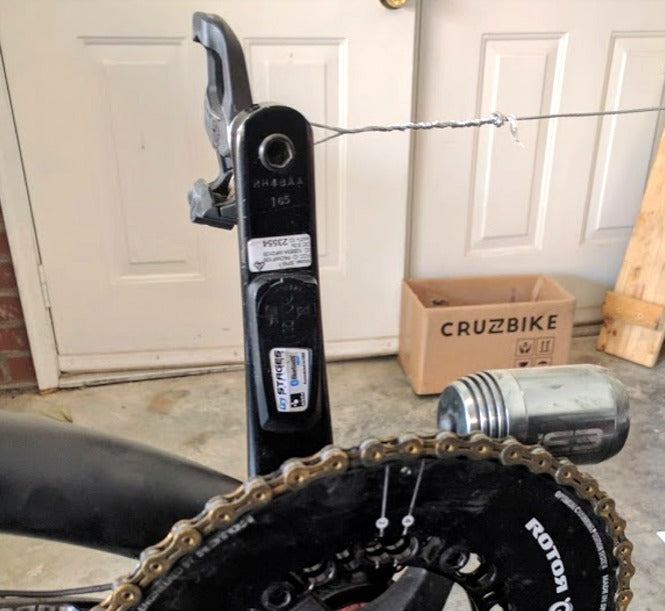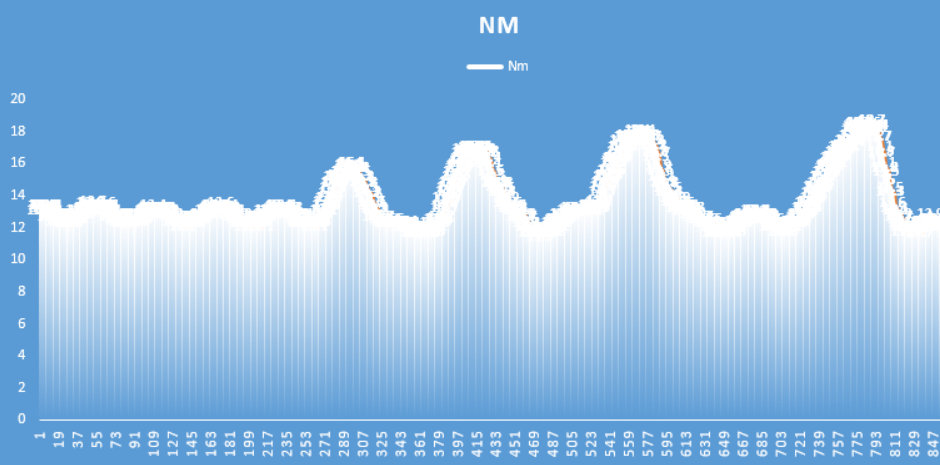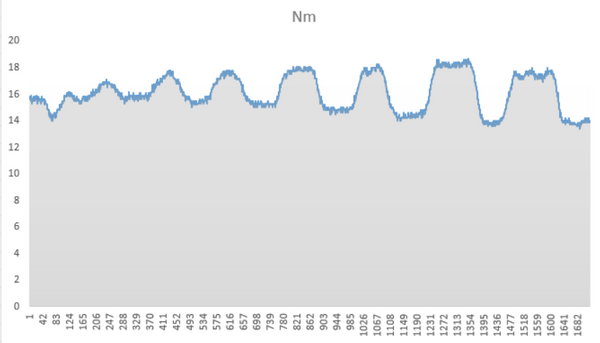Upper body aids propulsion on a Cruzbike bicycle
March 18, 2017/ Jim Parker
At last. Empirical, reproducible evidence to demonstrate what experienced Cruzbike riders have known all along.
The essential tool for this proof has been riding quietly with me for thousands of miles, but I did not recognize its capabilities until recently, after stumbling upon an article about a special feature of the Stages crank-based power meter called “high-speed data streaming”. Stages released an app that runs on my smart phone that receives and collects torque data from the left crank 64 times per second. That’s a crank torque measurement every 0.0156 seconds. The data not only flashes across the screen, but is saved to a CSV file for detailed analysis and graphing. This is a game-changer. Previously, I could analyze power data in 1-second increments, but that’s far too long for analyzing what happens during a small portion of a pedal stroke.
First, I sat on my V20 with the left crank in (or near-to) the 12:00 (straight-up) position, I applied a constant force with my left foot to the pedal and watched the torque numbers stream by on my device. The brake was engaged so the bike wouldn’t roll away and the crank would stay in a static position. The streaming torque numbers stayed relatively stable with minor variations as long as I held my foot pressure constant. Then I pulled gently on the left handlebar, I’d call it a “tug” or an impulse of a fraction of a second. The torque numbers shot up and then settled back down. Every pull got the same result… an increase in torque at the crank. Torque at the crank is propulsive force, so Q.E.D. (proof completed, or in Latin “quod erat demonstrandum”). But was I done? Had I proven it beyond a reasonable doubt, meeting the standards that Cruzbike’s toughest critics will demand? Of course not.
The obvious flaw is that the increased torque could very well have been due to me momentarily applying more force with my left leg (involuntarily or reflexively) every time that I pulled on the handlebar. To eliminate that possibility, I needed to replace my leg with a constant force of the same vector, but not subject to voluntary or involuntary changes. I attached the crank/pedal to a cable and pulley, and attached a 25 lb dumbbell to the other end of the cable.

Stages Power-meter crank cabled to a 25 pound dumbbell
Now there was a constant force on the crank, but voluntary (and reflexive/involuntary) leg forces had been removed from the system. The result with the dumbbell produced the same result, which was about a 30% spike in torque at the crank with each tug on the handlebar. Here is a graph of the actual data, with torque in Nm (Newton meter) on the Y-axis and time on the X-axis (because there are 64 data points/second total time is about 13-14 seconds):

Tugging gently on the handlebar produces a significant increase in torque at the crank.
The dumbbell created about 13 Nm of torque on the crank. You can see a slight oscillation due to the dumbbell gently swinging. Then you can see the four times that I pulled on the handlebar. Each pull significantly increased torque up to a total of 16 to 18 Nm. That’s about 30% more torque from just a little tug on the handlebar.
This video will show you the basic set up of the testing. My son, Will, helped out with the demo while I recorded video.
The next phase of the testing I replaced the dumbbell with three long bungee cords stretched out to a length of about 25 feet. I wanted to see if the torque increase would work the same with a mass-less force just the same as it did with the 25 lb dumbbell. Here is the graph of the high-speed data from the bungee testing:

Torque at the crank with bungee cords, and handlebar tugging – 26 second data-stream.
I wanted a long bungee cord length because a long length is going to give a nearly constant force when pulled a very short distance. A short bungee will yield increasingly more force as it is stretched a short distance.
As the graph above clearly shows, the torque went up when I tugged on the handlebar. There is a downward baseline drift of the torque, which I ascribe to using old bungees that don’t have truly elastic properties. Or else the crank arm moved from being 12:00 to something less, thus shortening the lever-arm length, and thus lowering the torque measurement. I did not quantify the force of my “pull”, but this could be done with a fish-scale… hook one end to the end of the handlebar, and pull on the other end. I tried to use an amount of force easily produced while riding.
Conclusion:
The upper body can do real mechanical work, specifically functional, propulsive work, by pulling or otherwise applying torque to the handlebar. This has now been shown by measuring an increase in torque at the crank, and illustrated by the elevation of a dumbbell, with handlebar tugging/turning. This is a major milestone in understanding the biomechanics of the Cruzbike. Whether or not Team Cruzbike sets a record in the 4-person RAAM (Race Across America) in June, Jason Perez beats everyone (again) in California’s toughest mountain double-centuries, or Cruzbike racers sweep the men’s recumbent categories at the 6-12-24 Hour World Championship (again)… this might be the most important Cruzbike milestone of 2017.
Discussion:
These results are easy enough for anyone with a Cruzbike and a Stages crank to verify. If you attempt to verify, please use eye protection in case a cable or bungee cord snaps or flies off.
While this testing only analyzed the increase in torque to the left crank with left handlebar tugging during the pedal downstroke, it would be expected to increase the torque in the left crank during the upstroke with right handlebar tugging (assuming the rider is clipped-in).
You may be wondering if I think tugging on the handlebar increases power (or torque) by 30% overall. The answer is I think it’s less than that. The 30% torque increase is during a snapshot in time. If that tug-impulse lasts about 20% of the downstroke, that would be approximately a 6% increase in overall torque. Therefore I’m going to estimate approximately a 6% increase in power is a practical and achievable estimate from the upper body technique. This may seem a small number, but it can make a huge difference in a race; especially a long race. More testing is definitely needed.
Optimal timing and intensity of the handlebar tugging are acquired skills best developed through deliberate practice during riding on the road, but can be practiced on a trainer, even though the motion of the front-end is highly constrained on a trainer. The aim is to turn the handlebar slightly so that the left pedal/BB moves slightly toward the left hip simultaneously as the left foot is making the powerful downstroke. A split second later the technique is used on the right, during the right foot’s downstroke.
Use of the upper body to add propulsive force is optional. Extra power is never “free”. However, there are great advantages to being able to distribute workload across numerous muscle groups. Muscles become depleted of metabolites. By-products like lactic acid build up within exhausted muscles. Maximum power can be increased and duration of exertion can be increased when more muscle groups are involved in the activity.
Comparison to other bicycle formats:
Rear-wheel-drive (RWD) recumbents cannot gain any power through this technique because tugging on a handlebar only turns the front wheel and imparts no motion (or torque) to the cranks. Most people think the much longer drive-chain and the extra idlers/chain-guides are why RWD recumbents may be slower at climbing. I believe the lack of upper body input is a bigger disadvantage.
On the other hand, standard bikes have this same capacity as Cruzbikes for torque on the handlebar causing increased propulsive torque at the crank. Actually, they have more of it because the standard bike frame may be leaned farther than a Cruzbike boom should be swiveled. However, they have a much higher energy cost to pay when they use this technique: 1) they MUST lift their body off of the saddle to allow the bike to rapidly lean side-to-side; and 2) they become much less aerodynamic in this position. Cruzbike riders can essentially use the technique continuously without either of these penalties. This advantage, in addition to the well known aerodynamic and ergonomic advantages, is why the Cruzbike is becoming the choice of performance-oriented recumbent racers and is the fastest climbing recumbent on the market.


Vi, now Im getting it.
Have been thinking, the front-wheel-drive was slightly nasty/bad, but no shit, its like straight the opposite: the whole body energy goes into forward-propulsion !
like these stretching-fitness-trainers
You PUSH the right leg and PULL by right arm/torso.
For my mental testing of this bike, thats in fact worth to ‘abuuuse’ :D -? increase the pedal/torque somehow even more.. ?? Making it a whole/bodz strumbling machine
ha I think thats up to +20?30%50 plus on energy, with the upper-body working/stretching, too
Thxfor answering
Leave a comment